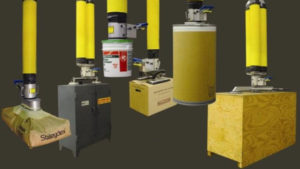 It may seem like it would be easy to tell a porous or a nonporous surface from one another. However, there is a common misconception that all hard surfaces are nonporous, and that simply isn’t true. Why does the surface type matter? When considering an industrial lifter, it is important to understand the difference between porous and nonporous surfaces so that you can find the best solution for your specific application. So, how can you tell if you are working with a porous or nonporous surface?
It may seem like it would be easy to tell a porous or a nonporous surface from one another. However, there is a common misconception that all hard surfaces are nonporous, and that simply isn’t true. Why does the surface type matter? When considering an industrial lifter, it is important to understand the difference between porous and nonporous surfaces so that you can find the best solution for your specific application. So, how can you tell if you are working with a porous or nonporous surface?
Nonporous Surfaces
Nonporous materials are defined as substances that do not allow liquid or air to pass through. Commonly known nonporous materials include glass, plastics, metals, and varnished wood. As the definition implies, utilizing vacuum lifting for nonporous materials is much simpler than with porous surfaces. Less airflow is needed to lift these materials because no air can pass through, meaning that high airflow is unnecessary.
The list of nonporous materials is exceedingly short, and it is a common misconception that all hard surfaces are nonporous. In reality, most hard surfaces are a combination of materials. Stainless steel, granite, and many other types of tiles are commonly misidentified as nonporous when they are, in fact, porous. Be sure to look beyond the surface to truly understand your material and how to effectively lift it.
Porous Surfaces
As the name would suggest, porous surfaces are surfaces that contain pores and are permeable to air and fluids. There are two kinds of porous surfaces, microporous and macroporous. Microporous surfaces are invisible to the naked eye but are still permeable to airs and liquids – making them harder to define as porous. Commonly misidentified microporous surfaces include stainless steel, laminate, and porcelain. In contrast, macroporous materials contains visible pores that allow for smooth movement of both airs and fluids through them.
Before high air flow vacuum lift systems were introduced, there were no safe or reliable methods for lifting very porous loads because too much air would permeate them. However, high flow vacuum systems are now able to compensate for air loss through typical porous load mediums such as corrugated carton flaps and paper bags, making them a secure and dependable solution for porous materials. In fact, high air flow that is provided by the regenerative blowers with vacuum life tubes will compensate for porosity and allow safe grip and lift every time.
Lift Loads with Any Surface
No matter what material you’re working with, the UniMove can lift it. With both standard and high air flow vacuum systems available, both nonporous and porous materials can be lifted safely and with ease. In fact, the UniMove offers the highest porous load lift capabilities in the industry.
To make the process even easier, UniMove dealers are available to visit your facility in order to determine which capacity UniMove lifter is needed for your products and to further determine the jib or bridge crane needed for your overhead support. All dealers are experienced in evaluating the capacity needs for your product. Most porous corrugated cartons display a Star Label indicating the Gross Weight Limit rating for your carton. If that rating is equal to or greater than the actual carton weight, then the carton can be lifted safely and easily. For highly porous Kraft paper bags the proper capacity UniMove is dictated by the construction of the bags. If you are unsure if your product can be lifted, contact UNIMOVE, LLC today! Products can be sent in for evaluation and a video of the lift will be provided to you.
